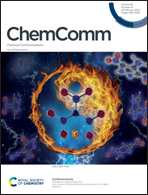Progress and prospects toward supramolecular bioactive ion transporters
Abstract
The majority of cellular physiological processes depend on natural ion channels, which are pore-forming membrane-embedded proteins that let ions flow across the cell membranes selectively. This selective movement of ions across the membranes balances the osmolality within and outside the cell. However, mutations in the genes that encode essential membrane transport proteins or structural reorganisation of these proteins can cause life-threatening diseases like cystic fibrosis. Artificial ion transport systems have opened up a way to replace dysfunctional natural ion channels to cure such diseases through channel replacement therapy. Moreover, recent research has also demonstrated the ability of these systems to kill cancer cells, reigniting interest in the field among scientists. Our contributions to the recent progress in the design and development of artificial chloride ion transporters and their effect on biological systems have been discussed in this review. This review would provide current vistas and future directions toward the development of novel ion transporters with improved biocompatibility and desired anti-cancer properties. Additionally, it strongly emphasises stimuli-responsive ion transport systems, which are crucial for obtaining target-specificity and may speed up the application of these systems in clinical therapeutics.



 Please wait while we load your content...
Please wait while we load your content...